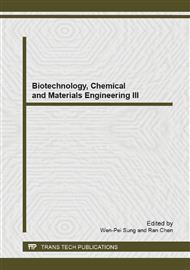p.41
p.46
p.51
p.55
p.59
p.64
p.68
p.73
p.78
Effect of Ionic Liquid Pretreatment on the Structure and Enzymatic Saccharification of Cassava Stillage Residues
Abstract:
Cassava stillage residue (CSR), the solid wastes generated from cassava-based bio-ethanol production, can be used to produce ethanol because of its high contents of cellulose. This study has focused on the pretreatment of CSR using the ionic liquid (IL) of 1-butyl-3-methyl imidazolium chloride ([Bmim]Cl). The changes in surface morphology, particle size and functional groups of pretreated CSR were examined by scanning electron microscopy (SEM), laser diffraction instrument and Fourier transform infrared (FTIR) spectroscopy. The results showed that [Bmim]Cl pretreatment could significantly damage the structure of cassava cellulose and increase the enzymatic saccharification rate.
Info:
Periodical:
Pages:
59-63
Citation:
Online since:
January 2014
Authors:
Price:
Сopyright:
© 2014 Trans Tech Publications Ltd. All Rights Reserved
Share:
Citation:


